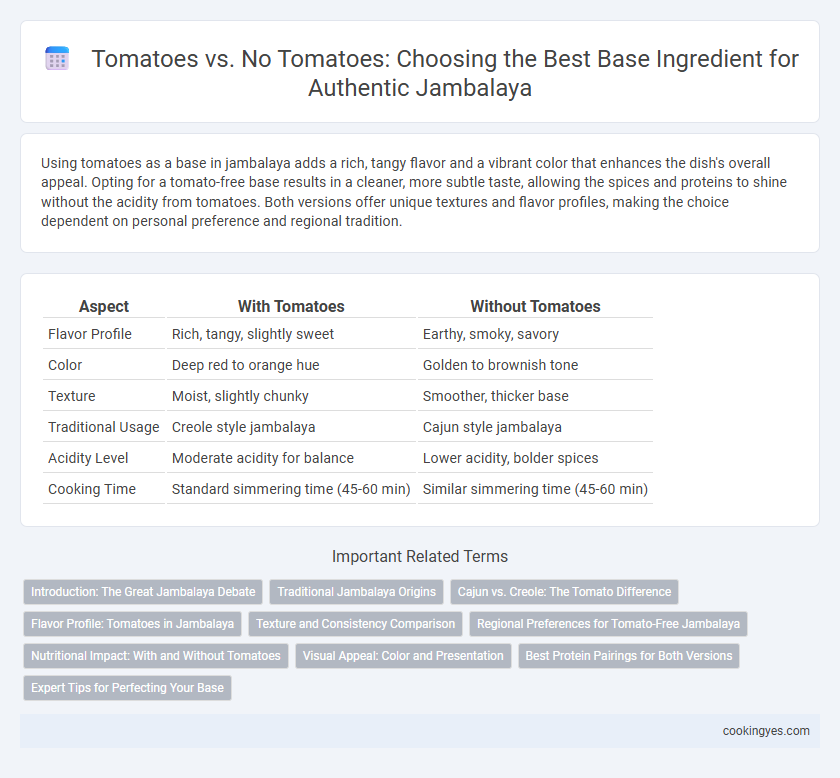Using tomatoes as a base in jambalaya adds a rich, tangy flavor and a vibrant color that enhances the dish's overall appeal. Opting for a tomato-free base results in a cleaner, more subtle taste, allowing the spices and proteins to shine without the acidity from tomatoes. Both versions offer unique textures and flavor profiles, making the choice dependent on personal preference and regional tradition.
Table of Comparison
| Aspect | With Tomatoes | Without Tomatoes |
|---|---|---|
| Flavor Profile | Rich, tangy, slightly sweet | Earthy, smoky, savory |
| Color | Deep red to orange hue | Golden to brownish tone |
| Texture | Moist, slightly chunky | Smoother, thicker base |
| Traditional Usage | Creole style jambalaya | Cajun style jambalaya |
| Acidity Level | Moderate acidity for balance | Lower acidity, bolder spices |
| Cooking Time | Standard simmering time (45-60 min) | Similar simmering time (45-60 min) |
Introduction: The Great Jambalaya Debate
The debate over using tomatoes in jambalaya centers on distinguishing the Creole and Cajun styles, with Creole jambalaya incorporating a tomato base while Cajun jambalaya relies on a stock or broth base without tomatoes. Tomatoes add acidity and sweetness, creating a distinctly rich, red sauce that influences the overall flavor and appearance. Excluding tomatoes highlights the smoky, savory elements from smoked sausage and spices, emphasizing traditional Cajun roots and a deeper, earthier profile.
Traditional Jambalaya Origins
Traditional jambalaya originates from Louisiana Creole and Cajun cultures, where the inclusion of tomatoes in the base distinguishes Creole jambalaya from its Cajun counterpart. Creole jambalaya typically incorporates a tomato-based sauce, reflecting Spanish and French culinary influences found in New Orleans, while Cajun jambalaya favors a rich, roux-based base without tomatoes, emphasizing smoky and spicy flavors. The choice between tomatoes or no tomatoes in jambalaya's base profoundly impacts its flavor profile, color, and historical authenticity tied to regional origins.
Cajun vs. Creole: The Tomato Difference
Cajun jambalaya typically excludes tomatoes, favoring a brown roux base that delivers a deep, smoky flavor profile rooted in Louisiana's rural traditions. Creole jambalaya embraces tomatoes, incorporating them to create a vibrant, tangy sauce reflective of New Orleans' French and Spanish cultural influences. This key ingredient distinction defines the visual appeal, taste, and regional identity of each jambalaya style.
Flavor Profile: Tomatoes in Jambalaya
Tomatoes in jambalaya provide a rich, tangy depth that enhances the dish's overall flavor complexity, balancing the savory and spicy elements with a subtle sweetness. The acidity of tomatoes brightens the flavor profile, creating a more vibrant and layered taste experience compared to tomato-free versions. Recipes with tomatoes often have a reddish hue and a slightly saucier texture, contributing to a heartier and more robust jambalaya base.
Texture and Consistency Comparison
Tomatoes in jambalaya create a thicker, more stew-like consistency with a slightly chunky texture that enhances moisture retention. Using no tomatoes results in a drier, more rice-forward dish where each grain remains distinct and the texture is lighter. The choice directly impacts the dish's mouthfeel, with tomatoes contributing to a heartier, more cohesive base while omitting them preserves the classic Creole style's firm texture.
Regional Preferences for Tomato-Free Jambalaya
Traditional Louisiana Creole jambalaya typically includes tomatoes as a base ingredient, infusing the dish with a rich, tangy flavor profile. In contrast, Cajun jambalaya, especially favored in southwestern Louisiana, omits tomatoes, instead relying on a smoky, brown roux and stock to create a savory, hearty base. Regional preferences strongly influence these variations, with tomato-free jambalaya gaining popularity in rural Cajun communities where slow-cooked, roux-based recipes preserve cultural authenticity.
Nutritional Impact: With and Without Tomatoes
Jambalaya with tomatoes provides an enhanced nutritional profile by contributing vitamins A and C, antioxidants like lycopene, and added fiber that support immune health and reduce inflammation. Conversely, jambalaya made without tomatoes may have a lower calorie content and reduced acidity, benefiting those with digestive sensitivities or acid reflux. Both variations offer balanced macronutrients, but the inclusion of tomatoes enriches the dish with essential micronutrients that promote cardiovascular health.
Visual Appeal: Color and Presentation
Jambalaya with tomatoes offers a vibrant red base that enhances visual appeal through rich, warm hues, creating an inviting and appetizing presentation. Without tomatoes, the dish maintains a golden-yellow color from the saffron or spices, presenting a more traditional and earthy visual style that highlights the textures of meats and vegetables. The choice between tomatoes or no tomatoes significantly impacts the dish's color palette, influencing the overall dining experience.
Best Protein Pairings for Both Versions
Jambalaya with a tomato base pairs exceptionally well with smoked sausage, chicken, and shrimp, as the acidity and sweetness of tomatoes enhance the savory flavors of these proteins. In contrast, the creole-style jambalaya without tomatoes favors pork, chicken, and seafood like crawfish or crab, allowing the smoky, spicy seasoning blend to shine without the added moisture from tomatoes. Choosing the right protein depends on the base; tomato versions balance richer meats with bright acidity, while non-tomato versions highlight the depth of spices alongside robust meats and shellfish.
Expert Tips for Perfecting Your Base
Expert chefs emphasize that choosing between tomatoes or no tomatoes as the base ingredient in jambalaya significantly influences its flavor profile and texture. Traditional Creole jambalaya often incorporates tomatoes, creating a rich, tangy foundation, while Cajun versions typically omit them for a smokier, meat-forward taste. Mastery of seasoning and cooking techniques tailored to either base ensures a balanced and authentic jambalaya experience.
Tomatoes vs No Tomatoes for base ingredient Infographic

 cookingyes.com
cookingyes.com